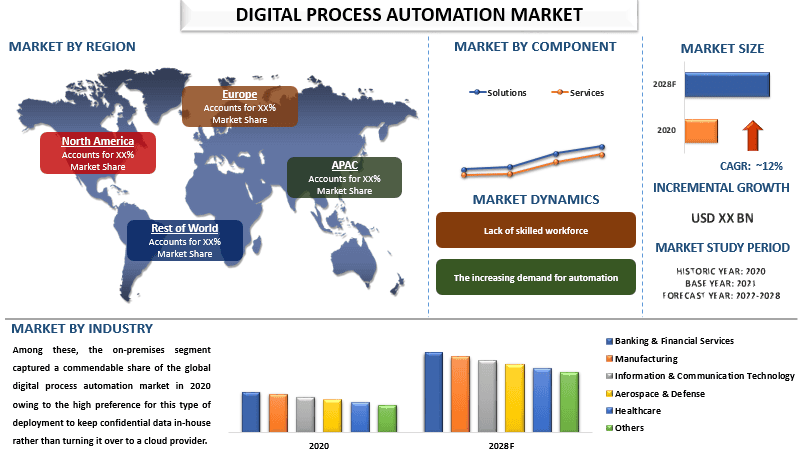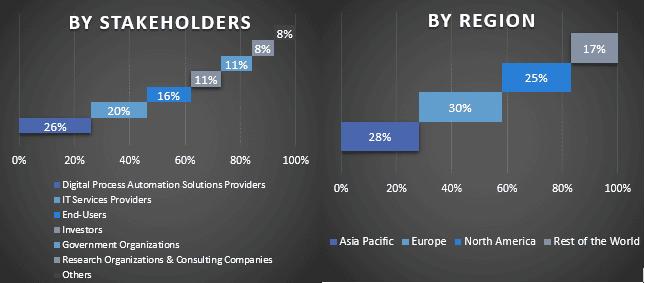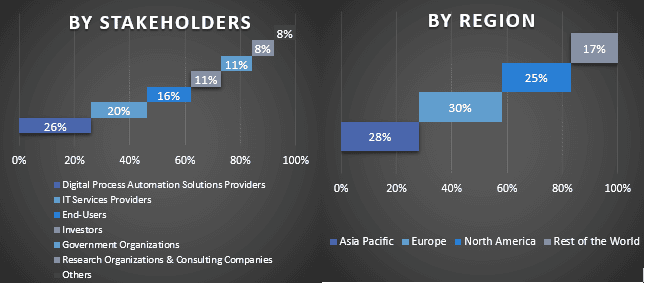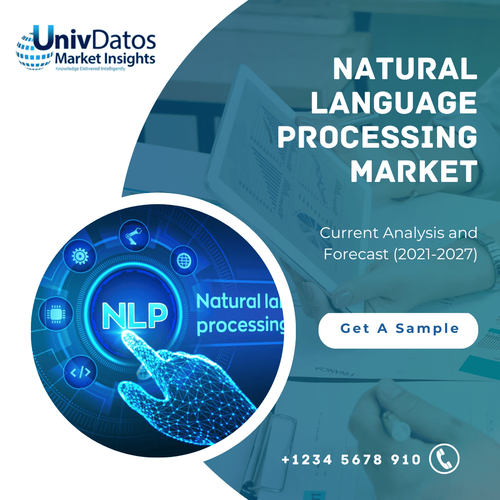Digital Process Automation Market: Current Analysis and Forecast (2022-2028)
Emphasis on Component (Solutions and Services); Business Function (Sales Process Automation, Supply Chain Automation, Claims Automation, and Marketing Automation); Deployment Type (On-premises and Cloud); Organization Size (Large Enterprises and SMEs); Industry (Banking and Financial Services, Manufacturing, Information and Communication Technology, Aerospace and Defense, Healthcare, and Others); and Region/Country

The Digital Process Automation Market is expected to grow at a strong CAGR of around 12% mainly due to the increasing demand for automation and the growing adoption of low-code automation platforms. The goal of digital process automation is to eliminate human intervention in business processes, freeing up employees to focus on higher value-added tasks. Key principles of digital process automation include maintaining transparency about processes, automating customer tasks, triggering notifications and reminders, and creating an atmosphere of collaboration. Many companies take the approach that they can reduce costs by simplifying work processes. With digital process automation, businesses can get their products to customers faster and deliver the same customer service experience with less employee effort. As a result, businesses can offer the same or better type of service at a lower cost. Furthermore, the expanding volume and variety of business data, and the increasing need for automation across industries are the main factors driving the growth of the digital process automation market. In addition, factors such as the increased adoption of IoT and the growing opportunities for automation across various industries are further contributing to the growth of the market. For instance, according to the United States Bureau of Labor Statistics, about 60% of occupations have at least 30% of their activities that are automatable.
Some of the major players operating in the market include IBM, Appian, Open Text Corporation, Bizagi, DXC Technology Company, Infosys Limited, Oracle, Pegasystems Inc., Cloud Software Group Inc, and Software AG. Several M&As along with partnerships have been undertaken by these players to facilitate customers with hi-tech and innovative products/technologies.
Insights Presented in the Report
“Amongst component, the solutions segment held a prominent share of the market in 2020”
Based on component, the market is bifurcated into solutions and services. The solutions segment catered to a significant share of the market in 2020 owing to the benefits associated with digital process automation such as time-saving, cost reduction, customer satisfaction, operation stability, error prevention, easy adaption, and others. The ability of digital process automation to organize and digitize processes makes it easier to adjust and improve. This enables companies to quickly launch new solutions, scale them, and adapt them to market needs.
“Amongst business function, the supply chain automation segment held a prominent share of the market in 2020”
By business function, the market is categorized into sales process automation, supply chain automation, claims automation, and marketing automation. Among these, the supply chain automation segment is expected to grow at a substantial CAGR during the forecast period. The globalization of business has led companies to adopt supply chain automation solutions to optimize their supply chain processes. Supply chain automation enables businesses to effectively capture and process orders from the earliest stages of planning, configuration, pricing, and order delivery.
“Asia-Pacific to grow at a strong CAGR during the forecast period”
The Asia-Pacific digital process automation market is anticipated to grow at a substantial CAGR during the forecast period. This is mainly due to the large-scale optimization of IT infrastructure, strong government initiatives, and ongoing projects. Moreover, improved technology, streamlined global supply chains, and the emergence of international logistics networks are other factors helping the Asia-Pacific digital process automation market grow rapidly.
Reasons to buy this report:
- The study includes market sizing and forecasting analysis validated by authenticated key industry experts.
- The report presents a quick review of overall industry performance at one glance.
- The report covers an in-depth analysis of prominent industry peers with a primary focus on key business financials, product portfolios, expansion strategies, and recent developments.
- Detailed examination of drivers, restraints, key trends, and opportunities prevailing in the industry.
- The study comprehensively covers the market across different segments.
- Deep dive regional level analysis of the industry.
Customization Options:
The global digital process automation market can further be customized as per the requirement or any other market segment. Besides this, UMI understands that you may have your own business needs, hence feel free to connect with us to get a report that completely suits your requirements.
Table of Contents
1. Market Introduction
- Market Definitions
- Main Objective
- Stakeholders
- Limitation
2. Research Methodology Or Assumption
- Research Process of the Digital Process Automation Market
- Research Methodology of the Digital Process Automation Market
- Respondent Profile
3. Market Synopsis
- Market Synopsis
4. Executive Summary
- Executive Summary
5. Global Digital Process Automation Market Covid-19 Impact
- Global Digital Process Automation Market Covid-19 Impact
6. Global Digital Process Automation Market Revenue, 2020-2028f
- Global Digital Process Automation Market Revenue, 2020-2028f
7. Market Insights By Component
- Solutions
- Services
8. Market Insights By Business Function
- Sales Process Automation
- Supply Chain Automation
- Claims Automation
- Marketing Automation
9. Market Insights By Deployment Type
- On-premises
- Cloud
10. Market Insights By Organization Size
- Large Enterprises
- SMEs
11. Market Insights By Industry
- Banking & Financial Services
- Manufacturing
- Information & Communication Technology
- Aerospace & Defense
- Healthcare
- Others
12. Market Insights By Region
- North America Digital Process Automation Market
- The United States
- Canada
- Rest of North America
- Europe Digital Process Automation Market
- Germany
- The United Kingdom
- France
- Italy
- Spain
- Rest of Europe
- Asia-Pacific Digital Process Automation Market
- China
- India
- Japan
- Rest of Asia-Pacific
- Rest of the World Digital Process Automation Market
- North America Digital Process Automation Market
13. Digital Process Automation Market Dynamics
- Market Drivers
- Market Challenges
- Impact Analysis
14. Digital Process Automation Market Opportunities
- Digital Process Automation Market Opportunities
15. Digital Process Automation Market Trends
- Digital Process Automation Market Trends
16. Demand And Supply-side Analysis
- Demand Side Analysis
- Supply Side Analysis
17. Value Chain Analysis
- Value Chain Analysis
18. Pricing Analysis
- Pricing Analysis
19. Strategic Insights
- Strategic Insights
20. Competitive Scenario
- Competitive Landscape
- Porters Fiver Forces Analysis
- Competitive Landscape
21. Company Profiled
- IBM
- Appian
- Open Text Corporation
- Bizagi
- DXC Technology Company
- Infosys Limited
- Oracel
- Pegasystems Inc.
- Cloud Software Group, Inc
- Software AG
22. Disclaimer
- Disclaimer
Research Methodology for the Digital Process Automation Market Analysis (2022-2028)
Analyzing the historical market, estimating the current market, and forecasting the future market of the global digital process automation market were the three major steps undertaken to create and analyze the adoption of digital process automation in major regions globally. Exhaustive secondary research was conducted to collect the historical market numbers and estimate the current market size. Secondly, to validate these insights, numerous findings and assumptions were taken into consideration. Moreover, exhaustive primary interviews were also conducted, with industry experts across the value chain of the global digital process automation market. Post assumption and validation of market numbers through primary interviews, we employed a top-down/bottom-up approach to forecasting the complete market size. Thereafter, market breakdown and data triangulation methods were adopted to estimate and analyze the market size of segments and sub-segments of the industry pertains to. Detailed methodology is explained below:
Analysis of Historical Market Size
Step 1: In-Depth Study of Secondary Sources:
Detail secondary study was conducted to obtain the historical market size of the digital process automation market through company internal sources such as annual reports & financial statements, performance presentations, press releases, etc., and external sources including journals, news & articles, government publications, competitor publications, sector reports, third-party database, and other credible publications.
Step 2: Market Segmentation:
After obtaining the historical market size of the digital process automation market, we conducted a detailed secondary analysis to gather historical market insights and share for different segments & sub-segments for major regions. Major segments are included in the report as component, business function, deployment type, organization size, and industry. Further country-level analyses were conducted to evaluate the overall adoption of testing models in that region.
Step 3: Factor Analysis:
After acquiring the historical market size of different segments and sub-segments, we conducted a detailed factor analysis to estimate the current market size of the digital process automation market. Further, we conducted factor analysis using dependent and independent variables such as the as component, business function, deployment type, organization size, and industry of the digital process automation market. A thorough analysis was conducted for demand and supply-side scenarios considering top partnerships, mergers and acquisitions, business expansion, and product launches in the digital process automation market sector across the globe.
Current Market Size Estimate & Forecast
Current Market Sizing: Based on actionable insights from the above 3 steps, we arrived at the current market size, key players in the global digital process automation market, and market shares of the segments. All the required percentage shares split, and market breakdowns were determined using the above-mentioned secondary approach and were verified through primary interviews.
Estimation & Forecasting: For market estimation and forecast, weights were assigned to different factors including drivers & trends, restraints, and opportunities available for the stakeholders. After analyzing these factors, relevant forecasting techniques i.e., the top-down/bottom-up approach were applied to arrive at the market forecast for 2028 for different segments and sub-segments across the major markets globally. The research methodology adopted to estimate the market size encompasses:
- The industry’s market size, in terms of revenue (USD) and the adoption rate of the digital process automation market across the major markets domestically
- All percentage shares, splits, and breakdowns of market segments and sub-segments
- Key players in the global digital process automation market in terms of products offered. Also, the growth strategies adopted by these players to compete in the fast-growing market
Market Size and Share Validation
Primary Research: In-depth interviews were conducted with the Key Opinion Leaders (KOLs) including Top Level Executives (CXO/VPs, Sales Head, Marketing Head, Operational Head, Regional Head, Country Head, etc.) across major regions. Primary research findings were then summarized, and statistical analysis was performed to prove the stated hypothesis. Inputs from primary research were consolidated with secondary findings, hence turning information into actionable insights.
Split of Primary Participants in Different Regions

Market Engineering
The data triangulation technique was employed to complete the overall market estimation and to arrive at precise statistical numbers for each segment and sub-segment of the global digital process automation market. data was split into several segments & sub-segments post studying various parameters and trends in the areas of the as component, business function, deployment type, organization size, and industry in the global digital process automation market.
The main objective of the Global Digital Process Automation Market Study
The current & future market trends of the global digital process automation market were pinpointed in the study. Investors can gain strategic insights to base their discretion for investments on the qualitative and quantitative analysis performed in the study. Current and future market trends determined the overall attractiveness of the market at a regional level, providing a platform for the industrial participant to exploit the untapped market to benefit from a first-mover advantage. Other quantitative goals of the studies include:
- Analyze the current and forecast market size of the digital process automation market in terms of value (USD). Also, analyze the current and forecast market size of different segments and sub-segments
- Segments in the study include areas of the as component, business function, deployment type, organization size, and industry
- Define and analysis of the regulatory framework for the digital process automation industry
- Analyze the value chain involved with the presence of various intermediaries, along with analyzing customer and competitor behaviors of the industry
- Analyze the current and forecast market size of the digital process automation market for the major region
- Major countries of regions studied in the report include Asia Pacific, Europe, North America, and the Rest of the World
- Company profiles of the digital process automation market and the growth strategies adopted by the market players to sustain in the fast-growing market
- Deep dive regional level analysis of the industry

You can also purchase parts of this report. Do you want to check out a section wise
price list?
Related Reports
Customers who bought this item also bought










